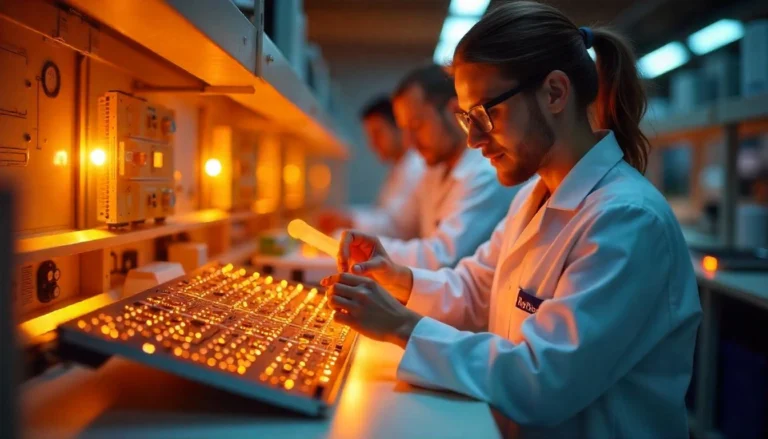Introduction
The rapid evolution of technology is reshaping industries at an unprecedented pace. Emerging technologies such as Artificial Intelligence (AI), Blockchain, the Internet of Things (IoT), and Automation are driving innovation across multiple sectors, enhancing efficiency, reducing costs, and creating new business models. According to a 2023 report by McKinsey & Company, digital transformation initiatives are projected to contribute $13 trillion to global GDP by 2030. This article provides a comprehensive analysis of how these technologies are revolutionizing key industries, the opportunities they present, and the challenges they bring.
The Role of AI in Industry Transformation
AI has emerged as one of the most disruptive technologies in modern business. Machine learning, natural language processing, and predictive analytics are being leveraged to optimize decision-making and automate processes across multiple sectors:
- Healthcare: AI-driven diagnostics, robotic surgery, and personalized medicine are revolutionizing patient care. For instance, AI-powered imaging tools from companies like IBM Watson and Google DeepMind can detect diseases such as cancer with greater accuracy than human radiologists.
- Finance: AI-driven fraud detection and algorithmic trading have significantly improved security and investment strategies. A report from PwC suggests that AI in financial services will generate $1.2 trillion in annual cost savings by 2030.
- Retail: Personalized recommendations and chatbots powered by AI enhance customer experience and drive sales. Amazon’s AI-driven logistics and inventory management systems have streamlined supply chain operations.
- Manufacturing: AI-powered predictive maintenance and smart robotics have enhanced operational efficiency, reducing downtime and maintenance costs by up to 20% in some factories, according to Deloitte.
Blockchain: A Game-Changer for Transparency and Security
Blockchain technology is redefining data security and transparency across industries. Initially associated with cryptocurrency, blockchain’s decentralized and immutable nature is now being applied in various sectors:
- Finance: Banks and financial institutions use blockchain for secure transactions and fraud prevention. The adoption of decentralized finance (DeFi) has grown exponentially, with the global blockchain market expected to reach $67.4 billion by 2026 (MarketsandMarkets report).
- Healthcare: Electronic health records (EHRs) secured with blockchain ensure data integrity and patient privacy, mitigating cybersecurity threats.
- Supply Chain Management: Companies like IBM and Walmart have implemented blockchain-based tracking systems to enhance traceability and reduce fraud in the food and pharmaceutical industries.
- Legal & Contracts: Smart contracts, which execute automatically when conditions are met, are streamlining legal and real estate transactions.
IoT: Connecting the Digital and Physical Worlds
The Internet of Things (IoT) is revolutionizing industries by enabling real-time data collection and analytics through connected devices:
- Healthcare: IoT-enabled wearables monitor patient vitals and alert healthcare providers to potential issues in real time.
- Smart Cities: IoT applications in traffic management, waste disposal, and energy efficiency are improving urban living conditions.
- Industrial IoT (IIoT): In manufacturing, IoT sensors monitor equipment health, reducing downtime and optimizing production efficiency. General Electric (GE) reports that IIoT has improved productivity by up to 25% in smart factories.
- Retail & Logistics: IoT-driven inventory tracking and fleet management have enhanced supply chain transparency and efficiency.
Automation: The Future of Workforce Efficiency
Automation is transforming industries by reducing reliance on manual labor and increasing productivity:
- Manufacturing: Robotic Process Automation (RPA) is replacing repetitive tasks, while collaborative robots (cobots) are working alongside human employees to enhance production lines.
- Customer Service: AI-powered chatbots and virtual assistants are improving customer engagement, reducing response times, and cutting operational costs.
- Agriculture: Automated irrigation systems and drone technology are optimizing crop yields and resource management.
- Banking & Finance: Automated risk assessment, robo-advisors, and AI-powered underwriting processes are making financial services more efficient.
Opportunities and Challenges
Opportunities:
- Increased operational efficiency and cost savings
- Enhanced customer experiences through personalization
- New revenue streams and business models
- Improved data security and regulatory compliance
Challenges:
- Cybersecurity risks and data privacy concerns
- Workforce displacement due to automation
- High implementation costs and integration complexities
- Regulatory and ethical considerations, particularly in AI and blockchain applications
Future Trends and Predictions
The future of industry transformation will be driven by continued advancements in AI, blockchain, IoT, and automation. Some key trends include:
- AI-powered autonomous systems in logistics and manufacturing
- Greater blockchain adoption for securing digital identities and cross-border payments
- Expansion of IoT ecosystems, integrating 5G technology for faster connectivity
- Hyperautomation, combining AI and RPA for end-to-end business process automation
Conclusion
Technology is undeniably transforming industries, reshaping traditional business models, and creating unprecedented opportunities. While challenges such as cybersecurity threats and workforce displacement must be addressed, the benefits of digital transformation far outweigh the risks. Organizations that embrace technological advancements and adapt to the digital era will be best positioned for long-term success.
By staying ahead of these trends and leveraging cutting-edge technologies, industries will continue to innovate, enhance productivity, and drive economic growth in the coming decades.

